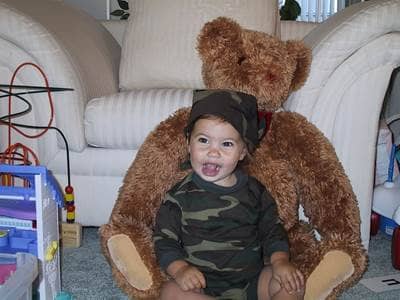
Each year 15,000 children and young adults are diagnosed with Type 1 diabetes. Previously known as juvenile diabetes, children suffering from this disease have trouble producing insulin and therefore must inject insulin several times a day or continually infuse insulin through a pump. For the parents of a child suffering with the disease, for which there is no known cure, the diagnosis of Type 1 diabetes can be devastating.
Dan Schnapp and his family know the heartbreak all too well. At just 13 months old, their daughter Amanda was diagnosed with Type 1 diabetes. I recently spoke with Dan about Amanda’s diagnosis, their family struggle and fight for a cure.
Tell me about Amanda’s diagnosis as a very young child.
I received a distraught call from my wife Jen confirming for me what I had feared when I reluctantly left town for a business trip that fateful Monday morning—my precious 13-month old baby girl was diagnosed with Type-1 diabetes. She had exhibited the symptoms for about a week or so (incessant thirst, excessive urination, exhaustion, etc.), but we wrote it off to lingering, side-effects of a virus accompanied by a high fever that she was fighting off the week prior to her admission to the hospital. The 2.5 hour flight home and drive to the hospital was tortuous to say the least. I have never felt so helpless and distraught when I first saw Amanda laying lethargic and unresponsive in a metal crib in the pediatric intensive care unit later that evening connected to multiple IV tubes and bags and heart, blood pressure and blood gas monitors. Her blood sugar levels were over 10x the normal range and she was in critical condition as diabetic ketoacidosis had begun to take hold with toxic ketones coursing through her tiny body. There is nothing more gut wrenching and heart breaking to a parent than to witness the suffering of your child and not have the ability to immediately relieve the pain.
What was life like after Amanda was diagnosis with Type 1 diabetes?
Needless to say, it was extremely difficult to manage Amanda’s condition when she was an infant and young toddler. She wasn’t able to articulate the way she was feeling and, consequently, we were compelled to look for physical signs of high and low blood sugar. Additionally, infants and small children don’t have the capability of comprehending the ramifications of the disease – you can’t force an infant or young child to eat when they are not hungry or feeling ill – something Amanda and every Type-1 diabetic must do in order to counteract the insulin administered throughout each day of their lives. Stomach viruses were particularly troublesome to deal with as a result. Insulin injections were hit or miss as her doctors were only able to provide best estimates for her insulin requirements. Drawing insulin into syringes was at best an inexact science as the dosages were often too small to even measure with the naked eye.
When Did You First Become Involved in Finding a Cure?
After coming home and realizing first-hand how exceedingly difficult and challenging it is to manage this disease, while simultaneously dealing with a young child’s normal physical and mental health/development, we were determined to dedicate a significant portion of our days toward raising funds to help find a cure and public awareness about the disease, its long-term complications, together with its treatment and corresponding side effects. We spent a week at the hospital training with pediatric endocrinologists, diabetes educators and nurses, learning how to administer insulin injections, check Amanda’s blood glucose levels, treat low blood sugars and give emergency glucagon injections in the event of severe hypoglycemia.
Tell us about how you learned about the JDRF and their Walk to Cure Diabetes. What inspired you to work with this organization?
We learned about the JDRF and the walk through a family friend whose son was diagnosed with Type-1 several years earlier as a teenager. She highly recommended the walk as an important, uplifting event for us and most importantly, Amanda. To this day, even after 10 years of preparation, contribution solicitations, etc., we look forward to walk day as it represents an opportunity to contribute to the cause and exhibit our support in numbers for all of those impacted by this terrible disease. We and scores of others on our walk team walk every year with the hope that our love and support will ease Amanda’s burden and apprehension, even for a fleeting moment. The JDRF, founded by parents of children with Type-1 diabetes in 1970, is truly a first-class not-for-profit organization, dedicated to finding a cure, which has raised over 1.5 billion dollars to achieve its goal since its inception – we have done and will continue to do all we can to support their efforts.
Last year, Amanda’s Army was 115 members strong. Since participating in JDFR’s Walk to Cure Diabetes, how much money have you raised and how?
For the past 10 years, we have been actively involved in the JDRF’s efforts to raise funds for a cure through its world-renowned “Walk to Cure Diabetes” walkathon, held on an annual basis each fall. During such time, we have raised nearly $300,000 from the generous and recurring contributions by multiple friends, family and colleagues who support and/or form part of our formidable walk team, Amanda’s Army. We have solicited donations through both traditional means (letter and email writing campaigns) and, recently, new media platforms (Facebook, personal websites and other social media portals). We have also held raffles and blind auctions featuring a variety of merchandise and services donated to charity by multiple corporations and businesses. We also are regular participants and donors for fundraising events held by local chapters of the Diabetes Research Institute, another top-notch organization dedicated to funding the research necessary to discover a cure.
Why do you think having a support network for diabetes is important, especially as a parent with a child diagnosed with Type-1 diabetes?
No one can ever know what it feels like to love a sick child. Whether it be diabetes or any other chronic illness. Your friends and family try to understand what you are going through, but unless they themselves have walked a mile in your shoes, they just aren’t able to fully grasp the gravity of the situation no matter how much they might want to help you. When our daughter was diagnosed, there was one woman who reached out to us and was the only person we knew who might be able to understand what we were going through. We appreciated her input and support so much that we have made it our goal to be available to any parent of a child with diabetes. Those first months after diagnosis are such a whirlwind and our daughter was one of the youngest children ever diagnosed with Type-1 diabetes in the Tri-state area. We have always felt that we were entrusted with our daughters care for a reason. And we both feel that if what we have gone through can help others in any way, then that would be reason enough for us.
How can other families struggling with this disease get involved?
Reach out to your local JDRF chapter – in addition to the annual walk, they hold multiple events throughout the year that always have room for participants. Talk to your child’s school and work with them to arrange and hold a fundraising event. Network with other parents through online forums (family support networks like www.childrenwithdiabetes.org) and social networks to connect with caregivers who, among other things, can offer support, practical advice and information regarding critical resources for your child (physicians, information regarding new treatments, 504 plans and strategies for school, summer camp, etc.)
How is Amanda today?
Today, Amanda’s life has become as normal as we can possibly make it. Every morning begins with testing her blood sugar before eating breakfast. She must carefully count the carbohydrates that she consumes in her breakfast in order to be able to administer the correct amount of insulin to herself. This is a process that occurs before every meal and snack every day. In addition she checks her blood sugar when she is feeling “off”. When Amanda feels lethargic, shaky or hungry, she recognizes that she might have a low blood sugar and needs to have a snack or glucose gel from a tube.
When Amanda feels thirsty or confused, she could conversely have a high blood sugar and need to take more insulin in order to counteract the hypergylcemia. This constant level of self-monitoring and care must occur 24 hrs a day, 7 days a week. If Amanda goes too long with a high blood sugar, she becomes dehydrated, nauseated and could slip into a coma. This can happen within a matter of hours. If a low blood sugar goes unnoticed and untreated, Amanda could become unconscious within minutes. Diabetes doesn’t care that its 4 o’clock in the morning or that she is sick and needs rest. It doesn’t care that she is in the middle of taking a test at school. Diabetes requires immediate attention no matter how “normal” a life Amanda is trying to lead.What is your advice to parents with children suffering with Type-1 diabetes?
Believe that a cure is coming, never give up despite how draining and difficult this life can be and try to keep your child as healthy as you can until that day comes.




